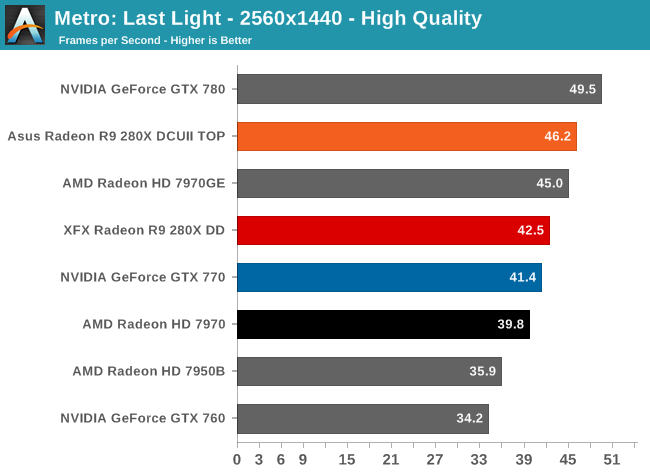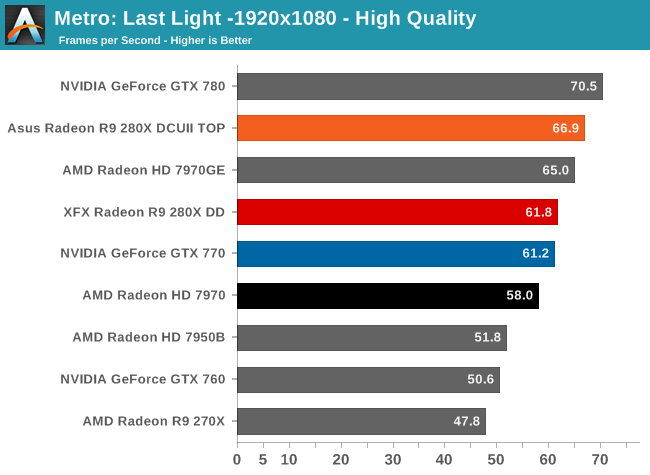The Radeon R9 280X Review: Feat. Asus & XFX - Meet The Radeon 200 Series
by Ryan Smith on October 8, 2013 12:01 AM ESTMetro: Last Light
Kicking off our look at performance is 4A Games’ latest entry in their Metro series of subterranean shooters, Metro: Last Light. The original Metro: 2033 was a graphically punishing game for its time and Metro: Last Light is in its own right too. On the other hand it scales well with resolution and quality settings, so it’s still playable on lower end hardware.



The first benchmark in our revised benchmark suite finds our 280X cards doing well for themselves, and surprisingly not all that far off from the final averages. Setting the baseline here, as we expected the Tahiti based 280X performs in between the original 7970 and 7970 GHz Edition, thanks to the 280X’s use of PowerTune Boost but at lower clockspeeds than the 7970GE. Consequently this isn’t performance we haven’t seen before, but it’s very much worth keeping in mind that the 7970GE was a $400 card while the 280X is a $300 card, so approaching the 7970GE for $100 less is something of a significant price cut for the performance.
As for the immediate competitive comparison, we’ll be paying particular attention to 2560x1440, which should be the sweet spot resolution for this card. At 2560 we can see that the reference clocked 280X doesn’t just hang with the $400 GTX 770 but actually manages to edge it out by just over a frame per second. As a preface we’re going to see these two cards go back and forth throughout our benchmarks, but to be able to directly compete with NVIDIA’s fastest GK104 card for $100 less is a significant accomplishment for AMD.
Finally, let’s quickly talk about the Asus 280X versus the XFX 280X. Asus winning comes as no great shock due to their factory overclock, but now we finally get to see the magnitude of the performance gains from that overclock. At 2560 we’re looking at just shy of a 9% performance gain, which is in excess of both the boost clock overclock and the memory overclock. The specific performance gains will of course depend in the game in question, but this means that the performance gains in at least one instance are being impacted by the base clock overclock, the larger of Asus’s factory overclocks.










151 Comments
View All Comments
AmdInside - Tuesday, October 8, 2013 - link
I still say its rebadge. The NVIDIA G92 went from 65nm to 55nm and lost analog TV out so by your definition G92 is not rebadged.Jumangi - Tuesday, October 8, 2013 - link
Yea that makes these totally different...ninjaquick - Tuesday, October 8, 2013 - link
What core difference exists between the 290X and the 280X? None really. The next gen's 370 is going to be a die-shrunk 280, and the 460 of the gen after that will be the same 7970 again. AMD is not going to bother releasing a new core design until the GCN is no longer apt for the task, which will only occur if HLSL/GLSL are retired completely.Gigaplex - Tuesday, October 8, 2013 - link
TrueAudio, some GPGPU instructions from GCN 1.1 plus whatever the 290X introduces on top of that is basically the core difference between 290X and 280X.Cellar Door - Tuesday, October 8, 2013 - link
I was looking forward to the R9 280X - simply because I hoped it would offer new features, revised silicon, maybe even new iteration of GCN. A REAL step forward - this is a let down. Because this hits my price point as I won't be able to afford their R9 290X, AMD was supposed to be a true champion of price - like always. It seems like I have no choice but to go with the green camp.silverblue - Tuesday, October 8, 2013 - link
Wait a minute... it trails the 770 on average by only a small amount and retails for $100 less. Sure, there's no game bundle, but how is this fleecing anybody?just4U - Tuesday, October 8, 2013 - link
One would think (since it's still pre-order status) that it's done in co-operation with their partners to help get rid of excess stock on the 7x line.. so Never settle bundles won't be offered until after all that is nearly gone. I suspect that such bundles will start being offered on the new line just as the holiday season starts.ltcommanderdata - Tuesday, October 8, 2013 - link
https://twitter.com/ID_AA_Carmack/status/386899206..."9x draw calls is credible over stock D3D, but Nvidia OpenGL extensions can give similar I mprocements."
In regards to Mantle, do you have any comment about John Carmack's report that AMD's claim of Mantle providing 9x more draw calls is already achievable by nVidia using their OpenGL extensions? Console porting is still an unique feature of Mantle, but on the draw call issue, if DirectX is slow to improve on this, then maybe AMD, Intel, and nVidia coming up with cross-vendor OpenGL extensions to address the issue may be a better solution than Mantle, especially given it converges with increased interest in OpenGL with SteamOS.
Pantsu - Tuesday, October 8, 2013 - link
AMD has made a similar statement. The new OpenGL extensions will bring similar improvements to what they advertise with Mantle, and that in the end the API will not be the bottleneck. As long as it's not Direct3D it seems. :D Perhaps even MS will eventually improve their game sooner or later.ananduser - Tuesday, October 8, 2013 - link
Have you not read Ryan's hunches on Mantle? Mantle is, or derived from, MS' low level Xbox API.